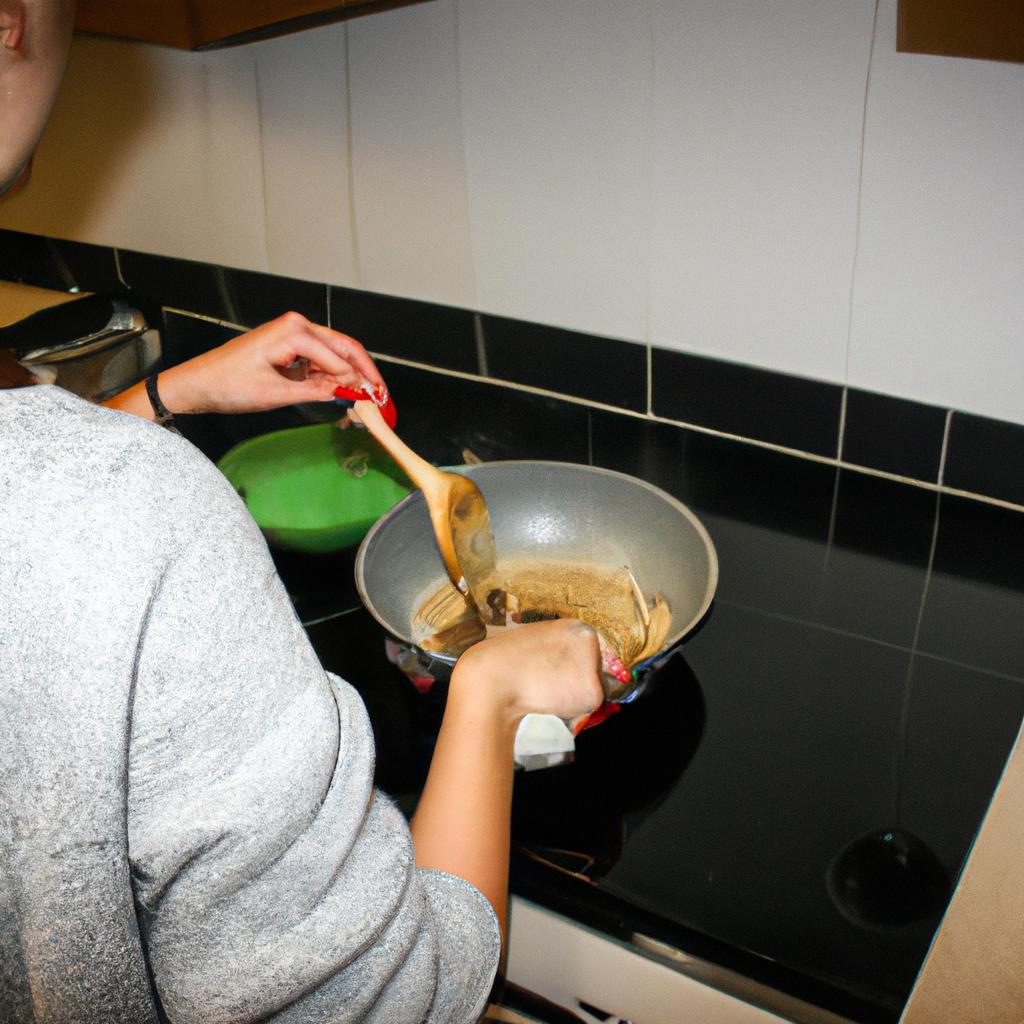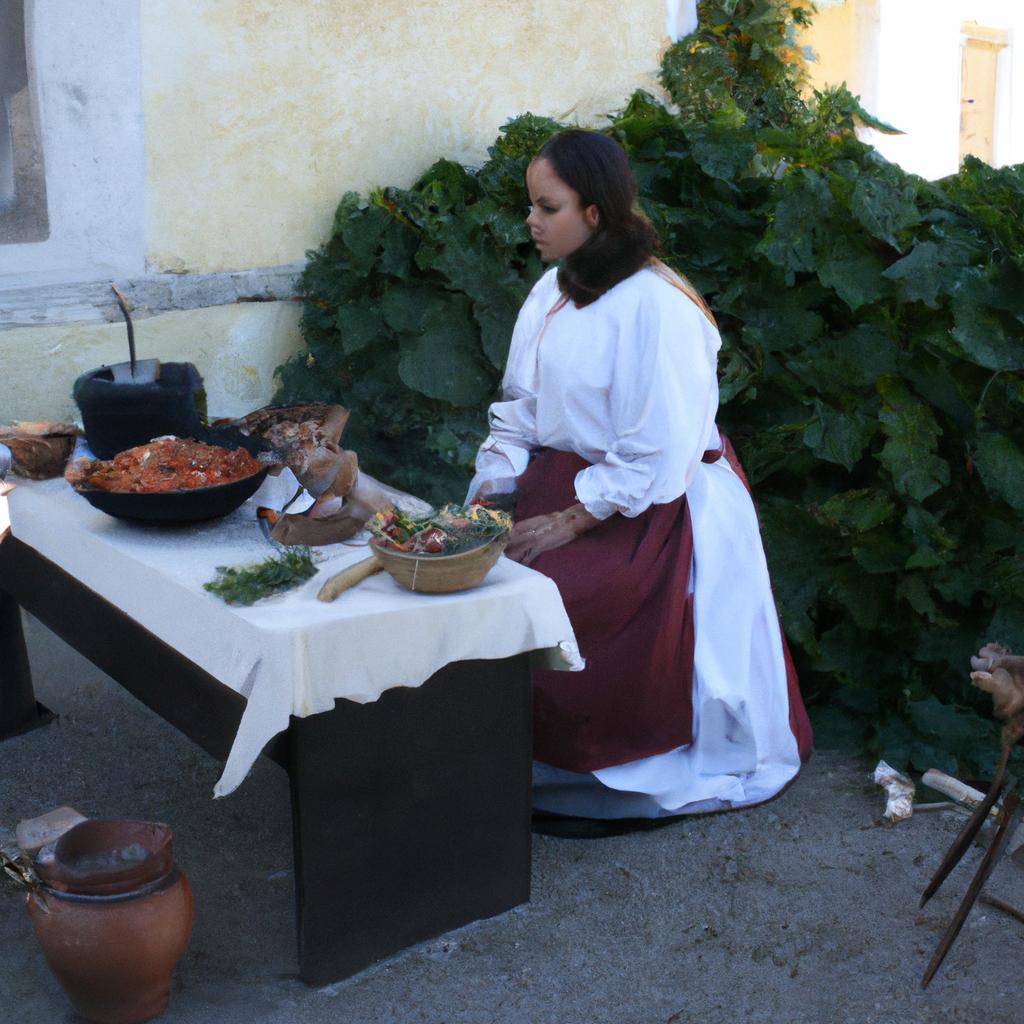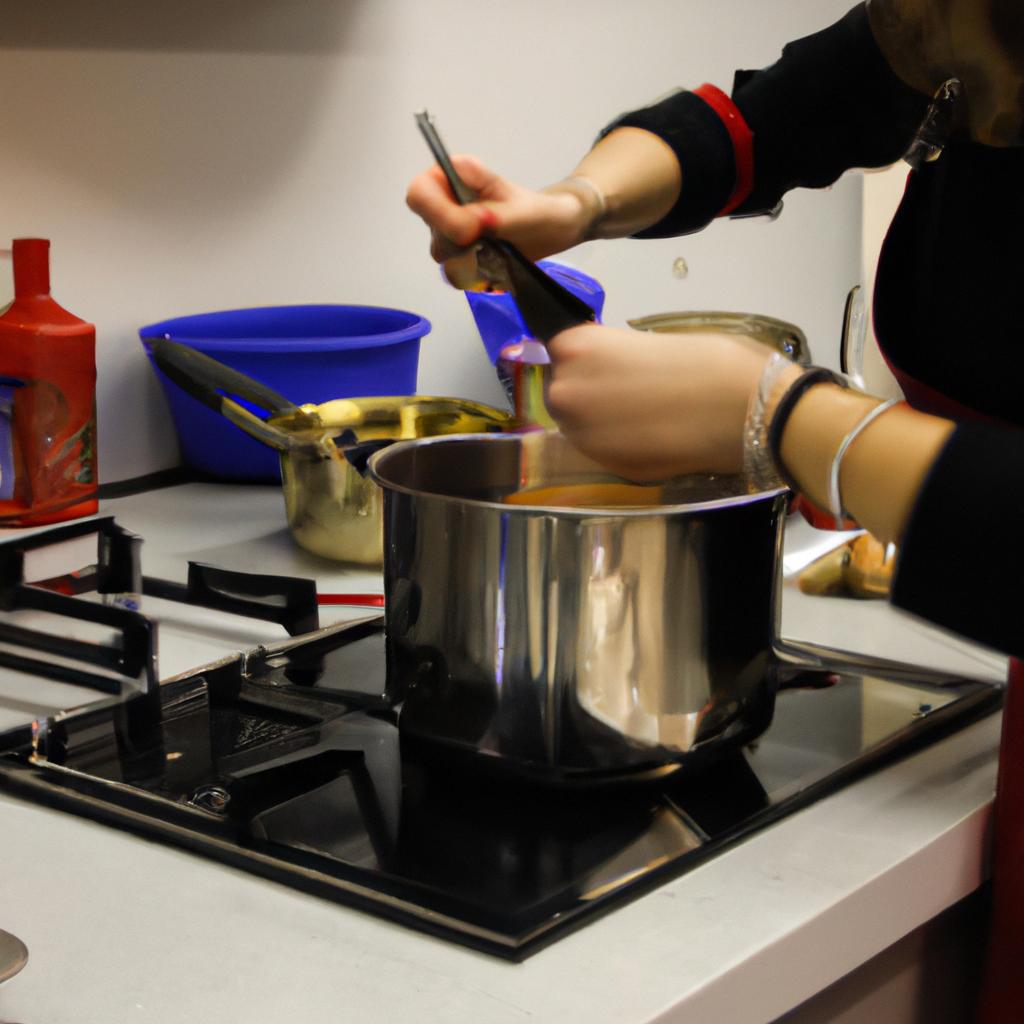Food photography has become increasingly popular in recent years, as people are becoming more interested in capturing and sharing their culinary experiences. Whether it’s a beautifully plated dish at a high-end restaurant or a homemade creation that showcases the skills of an avid home cook, food photography allows individuals to recreate and immortalize the artistry found within each meal. For instance, imagine a professional chef who wants to showcase his signature dessert – a delicate soufflé with intricate garnishes. Through skillful food photography techniques, he can capture not only the visual appeal but also convey the taste and texture of this delectable masterpiece.
In order to truly capture the essence of culinary arts through food photography, there are certain tips and tricks that can help photographers achieve stunning results. Lighting plays a crucial role in highlighting textures and colors while creating depth and dimensionality in photographs. The use of natural light is often preferred over artificial lighting sources as it enhances the authenticity of food imagery. Additionally, composition is another key aspect to consider when photographing food. By carefully arranging elements such as plates, utensils, and props, photographers can create visually pleasing compositions that draw viewers’ attention to the main subject – the delicious food itself.
By understanding these fundamental principles of food photography, aspiring photographers have the potential to capture mouthwatering images that not only showcase the beauty of food but also evoke a sense of culinary delight. Experimentation with different angles, perspectives, and focal lengths can further enhance the visual impact of food photography. Additionally, post-processing techniques such as adjusting exposure, color correction, and sharpening can help fine-tune the final image and bring out its true essence.
Furthermore, it is important to pay attention to styling details when photographing food. Small tweaks like adding fresh herbs or drizzling sauces can elevate the overall presentation and make the dish more visually appealing. Props such as tableware, napkins, and background elements should be carefully chosen to complement and enhance the subject without overpowering it.
Lastly, patience and practice are key in mastering food photography. It takes time to develop an eye for composition, lighting, and styling. Therefore, photographers should continuously explore new techniques, study other professional photographers’ work for inspiration, and experiment with various dishes to improve their skills.
By following these tips and dedicating themselves to honing their craft, aspiring food photographers can create captivating images that not only satisfy viewers’ visual appetite but also celebrate the artistry of culinary creations.
Understanding lighting techniques for food photography
Understanding Lighting Techniques for Food Photography
When it comes to food photography, lighting plays a crucial role in capturing the beauty and details of culinary creations. Properly understanding and utilizing lighting techniques can make all the difference in creating stunning photographs that truly showcase the artistry of food.
To illustrate this point, let’s consider an example: imagine a plate of vibrant green salad with colorful toppings. Without proper lighting, the colors may appear dull and flat, failing to convey the freshness and appetizing qualities of the dish. However, by using specific lighting techniques, such as backlighting or side-lighting, one can enhance the textures and colors, making the image more visually appealing.
In order to achieve professional-looking results in food photography, here are some key lighting techniques to keep in mind:
- Natural Light: Utilize natural light whenever possible; its softness and variability can add depth and dimension to your images.
- Diffused Light: Use diffusers or sheer curtains to soften harsh light sources and create gentle shadows that accentuate texture.
- Reflectors: Incorporate reflectors made from materials like foam boards or white cards to bounce light onto shadowed areas, reducing contrast.
- Artificial Lights: Experiment with artificial lights such as continuous LED panels or speedlights for more control over intensity and direction.
By combining these techniques strategically, photographers can evoke different moods in their food photography compositions. For instance, bright daylight might be ideal for showcasing fresh ingredients in a rustic setting while dimmer warm tones could evoke coziness when photographing comfort foods.
With an understanding of these various lighting techniques at hand, we can now move on to exploring another essential aspect of food photography – choosing the right props and backgrounds. This step will further enhance our ability to capture captivating culinary moments with artistic flair.
Choosing the right props and backgrounds for food photography
Understanding lighting techniques is crucial in food photography, as it can greatly enhance the visual appeal of your culinary creations. By strategically manipulating light sources and shadows, you can create depth, texture, and highlights that make food look more appetizing. One effective technique is using natural window light to achieve soft and diffused illumination. For instance, imagine a case where you are photographing a bowl of vibrant fruit salad on a rustic wooden table near a large window. The diffused morning sunlight gently illuminates the colorful fruits, casting subtle shadows that add dimension to the image.
To further elevate your food photography skills, consider implementing the following tips:
- Backlighting: Experiment with placing the light source behind or at an angle to the subject. This technique can create a beautiful halo effect around certain foods like beverages or translucent ingredients such as sliced citrus fruits.
- Light modifiers: Utilize diffusers or reflectors to modify the intensity and direction of light. A diffusion panel placed between the light source and subject will soften harsh shadows, while reflectors can bounce additional light onto darker areas for balanced exposure.
- Color temperature: Be mindful of color temperature when working with artificial lighting. Adjust white balance settings accordingly to ensure accurate representation of colors in your photographs.
- Avoid direct flash: Direct flash tends to produce unflattering results by washing out colors and creating harsh reflections. Instead, opt for indirect or bounced flash techniques for softer illumination.
In addition to mastering lighting techniques, selecting appropriate props and backgrounds plays a significant role in enhancing the overall aesthetic appeal of your food photographs. Consider incorporating these elements into your compositions:
| Props | Backgrounds |
|---|---|
| Unique utensils matching the cuisine style | Rustic wooden surfaces |
| Colorful linens or textured fabrics | Marble countertops |
| Fresh herbs or spices related to dish flavors | Neutral-toned ceramic plates |
| Decorative elements like flowers or vintage cutlery | Chalkboards with handwritten menus |
By thoughtfully selecting props and backgrounds, you can create a cohesive visual narrative that complements the food being photographed. Remember to strike a balance between adding interest without overwhelming the main subject.
In conclusion, mastering lighting techniques and carefully selecting props and backgrounds are essential components of capturing mouthwatering dishes in food photography. By leveraging natural light, exploring different lighting angles, and utilizing modifiers effectively, you can enhance the appeal and allure of your culinary creations. Furthermore, incorporating appropriate props and backgrounds adds depth and visual interest to your compositions. In the following section about composition and framing tips for capturing mouthwatering dishes, we will delve into how these elements work together to create stunning food photographs.
Composition and framing tips for capturing mouthwatering dishes
Building upon the importance of choosing the right props and backgrounds for food photography, let’s explore another crucial aspect that can elevate your culinary captures to a whole new level. In this section, we will delve into composition and framing tips that allow you to create visually appealing images that tantalize the taste buds.
Paragraph 1:
To understand how composition and framing play an integral role in food photography, consider the following scenario: imagine capturing a delectable chocolate cake on a plain white plate against a simple background. Now, picture the same cake presented on an intricately patterned vintage china plate with vibrant flowers as a backdrop. The latter image not only provides more visual interest but also enhances the overall appeal of the dish. By thoughtfully selecting props and backgrounds that complement your subject, you can evoke emotions such as nostalgia or elegance while enticing viewers with mouthwatering visuals.
Bullet Point List (Markdown format):
- Integrate elements from nature like fresh herbs or fruits to add vibrancy and freshness.
- Use contrasting colors to create visual impact and highlight specific ingredients.
- Experiment with different textures by incorporating fabrics or textured surfaces.
- Incorporate negative space strategically to draw attention to the main subject.
Table (Markdown format):
| Composition Techniques | Examples |
|---|---|
| Rule of Thirds | Placing key elements along intersecting lines |
| Leading Lines | Using diagonal lines to guide the viewer’s eye |
| Symmetry | Creating balance through symmetrical arrangements |
| Framing | Utilizing objects around the dish to frame it |
Paragraph 2:
By employing these composition techniques, you can effectively captivate your audience and bring forth their emotional connection to food. Remember, each element within your frame should contribute harmoniously without overwhelming the main dish itself. Strive for simplicity in order to showcase tastes rather than distractions. Consider how leading lines can guide one’s gaze to the focal point, or how symmetry can create a sense of order and balance. Experimentation is key in finding what works best for each dish and capturing its essence through composition.
With an understanding of composition techniques under our belt, let’s now explore how color and texture can be harnessed to further enhance food photography.
Utilizing color and texture to enhance food photography
Building on the foundation of composition and framing, the next essential aspect to consider in food photography is utilizing color and texture. By strategically incorporating these elements into your images, you can enhance visual appeal and evoke a strong emotional response from viewers. Let’s explore how you can leverage color and texture to capture culinary artistry at its finest.
One effective way to utilize color in food photography is by understanding the principles of color theory. For instance, complementary colors, such as blue and orange or red and green, create a visually striking contrast that can elevate your image. Consider using props or backgrounds with complementary hues to make the dish truly pop. Additionally, playing with monochromatic schemes—using different shades of one dominant color—can add depth and sophistication to your compositions.
Texture also plays a crucial role in creating captivating food photographs. Highlighting the various textures present in a dish can entice viewers’ senses and make them crave for what they see. Experiment with contrasting textures like smooth sauces against crunchy toppings or soft desserts paired with crispy garnishes. By emphasizing these contrasts through careful lighting techniques and thoughtful styling choices, you can bring out the tactile qualities of the ingredients.
To further illustrate the impact of color and texture in food photography:
- Imagine capturing an elegantly plated seafood linguine dish featuring vibrant red tomatoes alongside fresh green basil leaves atop al dente pasta strands glistening with olive oil—a harmonious display of complementary colors that brings forth both richness and freshness.
- Visualize a rustic apple pie photographed against a weathered wooden backdrop, where the flaky golden crust provides a delightful textural contrast to the tender fruit filling bubbling beneath it—a mouthwatering combination that appeals not only visually but also evokes nostalgic feelings associated with home-baked treats.
By consciously considering color combinations and highlighting textures within your frame, you have the power to immerse viewers in a sensory experience that goes beyond mere visual appreciation.
Mastering the art of food styling for captivating images, let’s now delve into techniques that can take your culinary photography to the next level.
Mastering the art of food styling for captivating images
Building on the previous section’s exploration of color and texture, this section delves into the art of food styling to create captivating images that entice viewers. To illustrate these concepts in action, let us consider a hypothetical scenario involving a professional food photographer tasked with capturing an array of delectable desserts for a high-end bakery’s promotional materials.
Food Styling for Captivating Images
The key to successful food styling lies in presenting dishes in their most aesthetically pleasing form while maintaining their authenticity. In our hypothetical case study, the food photographer collaborates closely with the baker to ensure each dessert is carefully arranged and garnished before being photographed. By employing various techniques such as layering ingredients, drizzling sauces elegantly, or strategically placing edible decorations like fresh berries or mint leaves, the photographer can enhance visual appeal and evoke desire in potential customers.
To further engage viewers’ emotions through imagery, here are some effective strategies used by seasoned food photographers:
- Incorporating props: Utilizing complementary objects like vintage plates, rustic wooden boards or linen napkins adds depth and context to the image, evoking feelings of nostalgia or warmth.
- Creating dynamic compositions: Experimenting with different angles and perspectives allows photographers to capture unique shots that emphasize textures and heighten sensory experiences.
- Playing with lighting: Manipulating natural or artificial light sources can accentuate certain aspects of the dish while casting intriguing shadows that add drama or intrigue.
- Showcasing interaction: Including human elements such as hands reaching for a slice of cake or pouring syrup over pancakes creates relatability and invites viewers to imagine themselves indulging in the culinary delights presented.
| Strategies | Emotive Response |
|---|---|
| Use of props | Nostalgia / Warmth |
| Dynamic compositions | Visual interest / Intrigue |
| Lighting manipulation | Drama / Ambiance |
| Interaction element | Relatability / Desire |
Incorporating these techniques, our hypothetical food photographer successfully captures the bakery’s desserts in a visually stunning manner. Such images not only showcase the culinary artistry but also evoke viewers’ emotions and entice them to explore further.
With an understanding of effective food styling techniques established, the subsequent section delves into post-processing tips for enhancing food photographs, elevating their visual impact even further.
Post-processing tips for enhancing food photographs
Building upon the skills of food styling, mastering post-processing techniques is essential for enhancing and perfecting food photographs. By utilizing various editing tools and software, photographers can elevate their images to new heights, ensuring that every detail captures the essence of the culinary artistry on display.
To illustrate the impact of post-processing in food photography, let’s consider a hypothetical case study involving a professional photographer attempting to capture an exquisite plate of sushi rolls. The initial photograph showcases vibrant colors and intricate details but lacks the desired visual appeal due to some imperfections such as minor shadows and distractions in the background.
Post-Processing Techniques:
- Color Enhancement: One crucial aspect of post-processing is adjusting colors to enhance their vibrancy and make them more enticing. Through selective adjustments or global changes using software like Adobe Lightroom or Capture One, photographers can bring out the natural hues of ingredients while maintaining their authenticity.
- Sharpening and Clarity: Ensuring crispness and clarity are vital for food photography. Utilizing sharpening techniques helps accentuate textures, making each ingredient appear more delectable and inviting. Additionally, adjusting clarity selectively can emphasize specific areas within an image to create depth.
- Background Cleanup: A cluttered background distracts from the main subject – the food itself. In post-processing, removing any unwanted elements or blemishes can significantly improve the overall composition by directing attention solely towards the culinary masterpiece.
- Composition Refinement: Post-processing allows photographers to refine composition through cropping or straightening horizons if necessary. These small adjustments help achieve better balance and aesthetic harmony within the frame.
| Post-Processing Techniques | Impact |
|---|---|
| Color Enhancement | Enhances vibrancy and entices viewers |
| Sharpening and Clarity | Accentuates textures for a crisper appearance |
| Background Cleanup | Removes distractions, focuses on the main subject |
| Composition Refinement | Achieves better balance and aesthetic harmony |
Through skillful post-processing techniques, photographers can elevate their food photographs to truly capture the essence of culinary artistry. By enhancing colors, sharpening details, cleaning up backgrounds, and refining composition, these editing tools become invaluable in creating captivating images that leave a lasting impression on viewers. With practice and mastery of post-processing methods, photographers can fully unleash their creativity and showcase the true beauty of gastronomy.
 Refoksa
Refoksa



